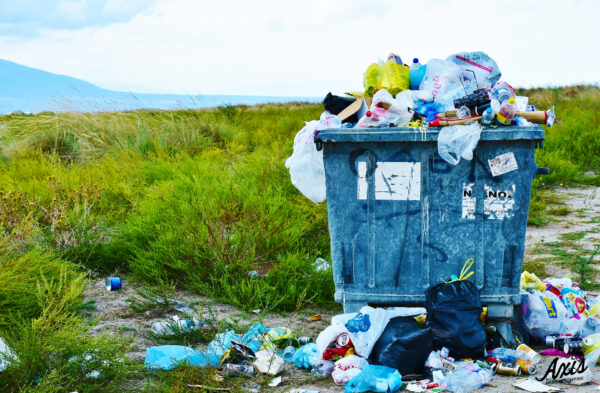10 Tips for the Eco-Friendly Travel Nurse

As a travel nurse, you’re constantly on the go, moving from one hospital to the next. Unfortunately, that also means burning literal tons of fossil fuels, with lots of long drives and airplane flights. According to the EPA, a typical passenger vehicle emits 4.7 metric tons of carbon dioxide per year, and a single flight from New York to Los Angeles emits about 20% of that. Of course, people still need to get from point A to point B, and many working professionals still have to travel frequently. So what are some ways you can reduce your carbon footprint? Here are 10 tips to help you be more eco-friendly when you travel!
1. Recycle and Compost
You can significantly mitigate your environmental impact by recycling and composting more, and throwing away less. In 2017, the national recycling rate was only 35% nationwide, and the composting rate was much lower at under 6%. When you start a travel contract, do some research on recycling and composting services in your new city, and check to see if where you’ll be living has curbside recycling pickup.
Looking for your next gig? Search our available jobs here!
In general, be more conscious of what you throw away. Common recyclable materials include glass, plastic, aluminum cans, cardboard, and paper products. Composting is for materials that are biodegradable such as yard and food waste. Here’s an Axis Pro Tip: keep a food waste receptacle in your kitchen so it doesn’t end up in the trash. Recycling and composting can help save energy, conserve natural resources, and create new green jobs!

2. Use Reusable Bags
Plastic bags are very harmful to animals who mistake them for food, and contribute significantly to the pollution of our oceans. It can take 500 years or more for a plastic bag to degrade in a landfill, and only 1% of plastic bags in use end up being recycled. One way to reduce plastic pollution is by using reusable bags when you shop for groceries, and saying no when they ask if you want a plastic bag at shopping malls and retail stores. Here’s an Axis Pro Tip: keep a few reusable bags in your car so you never forget to bring them to the store!
3. Don’t Buy Bottled Water
Speaking of single-use plastic, a great way to reduce plastic pollution is by getting in the habit of using refillable water bottles instead of bottled water. Not only does it reduce plastic waste, it stops bottled water companies from stealing natural water reserves from our communities for profit. Hydro Flask makes fantastic reusable bottles and coffee tumblers that are designed to keep your drink cold or hot all day long. Here’s an Axis Pro Tip: take advantage of water bottle refilling stations at work or at the airport. For coffee drinkers, make a habit of bringing your reusable mug when you go out for coffee.

Human hugging big tree color of hipster tone selective soft focus, concept protect environment
4. Use Public Transit
Utilizing public transit options like the bus, light rail, or subway, can help minimize your carbon footprint and dramatically reduce air pollution. If it’s convenient, try using public transit for your commute to work. Some hospitals are even partnered with county and state transit services to offer discounted rates to commuters, so check with your supervisor to see if that’s an option. Here’s an Axis Pro Tip: familiarize yourself with the mass transit options in your area and make an effort to drive less. If you only need to go a short distance, try walking or biking to your destination. If commuting on public transit isn’t an option, see if you can carpool to work.
5. Reduce Your Meat Consumption
One of the biggest ways you can mitigate carbon emissions is by reducing or eliminating your meat consumption. Producing one kilogram of beef emits 60 kg of greenhouse gasses, compared to just 7 kg for poultry, and 1 kg for peas. If everyone in America reduced their meat consumption by 25%, we would save 82 million metric tons of greenhouse gas emissions per year. Here’s an Axis Pro Tip: Focus on incorporating more vegetarian meals into your diet, and look for plant-based proteins to substitute for meat.

6. Eat and Drink Local
When you’re out and about looking for places to eat and drink, try restaurants and bars that utilize local ingredients. The concept of the farm-to-table restaurant is growing in popularity, and many restaurants across the nation are adopting this style. Here’s an Axis Pro Tip: try to buy local, responsibly sourced food, and only buy fruits and vegetables when they’re in season. Shop at grocery stores like Whole Foods, or co-ops and farmers markets that focus on environmentally sustainable food.
7. Respect the Natural Environment
When you’re enjoying the beautiful parks and natural areas that our country has to offer, be conscious of your impact on the ecosystems around you. Many of our national parks have a Leave No Trace policy. That means if you pack it in, pack it out. Also, it’s important to respect the wildlife and stay on marked paths and trails when hiking. Remember that this is their home, and you’re just visiting. Some parks like Denali National Park encourage visitors to hike off-trail, but make sure you research your route or talk to a ranger before you go. Here’s an Axis Pro Tip: work on practicing Leave No Trace principles, even if you’re just taking your dog for a walk.

8. Stay at Eco-Friendly Hotels
If you’re staying in a hotel, do some research to find accommodations that focus on environmental sustainability. Hotel chains like Fairmont and Hyatt have been praised for their commitment to being eco-friendly, and there are things you can do limit your environmental impact when you stay. For instance, many hotels will ask if you want your sheets and towels changed daily. Here’s an Axis Pro Tip: by simply reusing your sheets and towels during your stay, you can save energy, conserve water, and minimize your footprint.
Need Housing? Check the Top 5 Housing Websites for Travel Nurses!
9. Look for Eco-Friendly Housing
When you’re looking for housing, ask your recruiter if they know of eco-friendly housing options in the area you’re relocating to. Eco-friendly housing doesn’t have to be a completely green home, it could mean housing that offers recycling services, or maybe a place with a community vegetable garden. Here’s an Axis Pro Tip: if you’re moving to a place that gets tons of sun, see if you can find housing that has solar panels. You can reduce your carbon emissions, and also sell the excess energy back to the grid, which can help offset your utility costs.
10. Buy More Eco-Friendly Products
Now that you’re more savvy on environmental sustainability, you can focus on buying more eco-friendly products when you shop. Production of goods like clothes, cosmetics, soaps, cleaners, weed killers, etc. can all have negative consequences on the environment. Here’s an Axis Pro Tip: being conscious of what you put in your shopping cart, how it was made, and where it came from, can have a huge impact on reducing pollution, deforestation, and habitat loss worldwide.

Traveler favorite destinations become favorites because of the abundance of land and sea to see and explore. Let’s do our part to ensure these places are here to enjoy for centuries to come.
Still researching? Apply today and chat with a recruiter directly!
- Five Reasons to Visit Washington State - October 11, 2023
- Travel Nursing Assignments – Seattle: Live Like A Local - October 11, 2023
- Traveler of the Month: Ciene G! - January 27, 2023
























